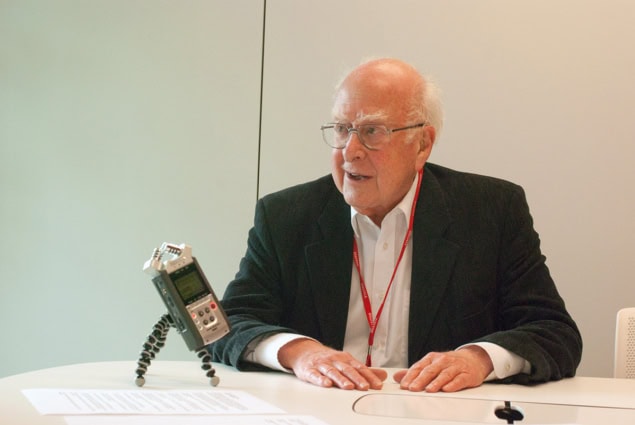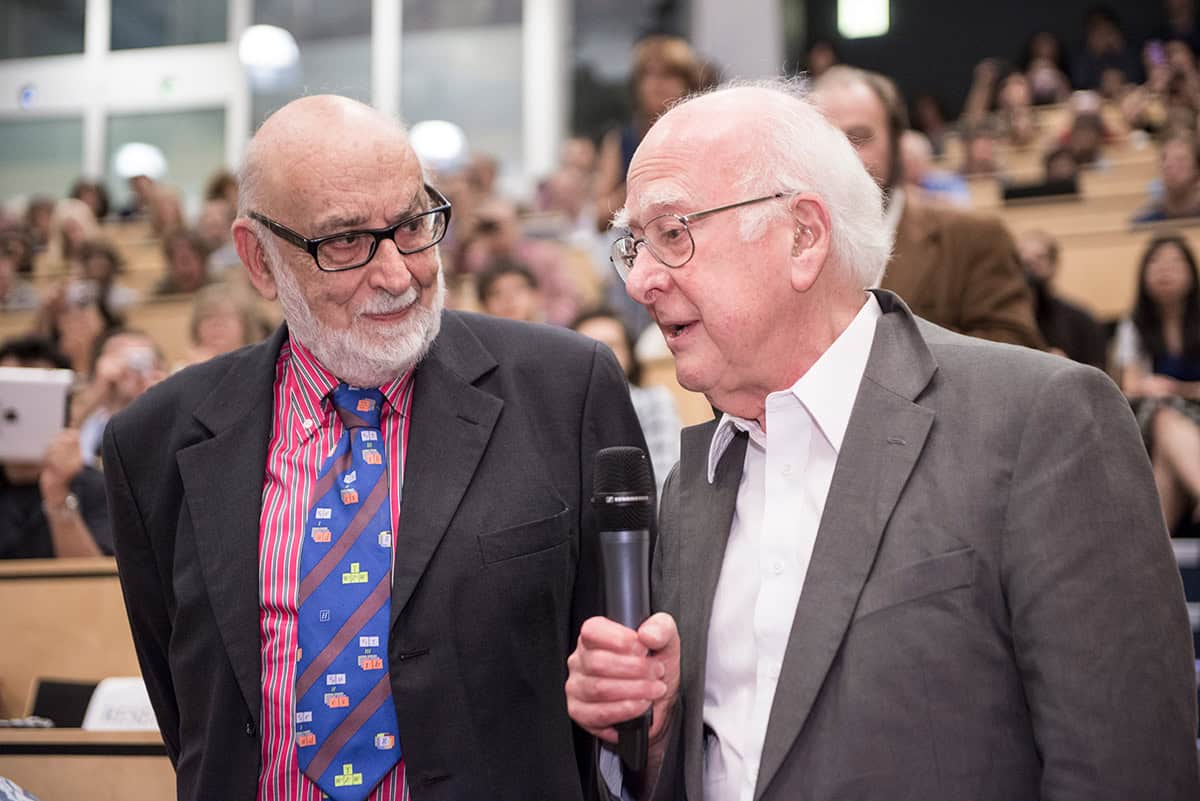The Nobel-prize-winning particle theorist Peter Higgs, who died in April 2024 aged 94, was a reclusive figure who preferred to stay out of the limelight. But in May 2012 he agreed to an audio interview with Physics World editor Matin Durrani – an edited version of which is presented here for the first time

You’re best known for the boson that bears your name, but do you still feel uncomfortable, as you’ve expressed in the past, in having your name attached to it?
Well, I feel more comfortable with my name attached to the boson than having my name attached to anything else in that theory – simply because, of the half-dozen people who were involved in the theory at the time, around 1964, I was the only one who drew attention to its existence. I mean it wasn’t that I in any way invented it [the Higgs boson] as part of the theory, but I pointed out it was there as a result of having had the first version of my paper rejected.
It went to Physics Letters – the editor in Geneva apparently passed it along the corridor for somebody to referee, and they didn’t see what the point was. So it got sent back to me and I was annoyed and thought “Well, I’d better extend it in some way to give some indication of the consequences of theorising in this way.” And that’s when I drew attention to its existence. [Higgs’ paper “Broken symmetries and the masses of gauge bosons” eventually appeared in the 19 October 1964 edition of Physical Review Letters (13 508) – see “Spontaneous symmetry breaking explained” box.]
Who else, apart from you, deserves credit for that idea?
If you’re talking about the whole theoretical structure, it certainly involves six people, who shared the Sakurai prize in 2010. That’s [Robert] Brout, [François] Englert, myself, [Gerald] Guralnik, [Carl] Hagen and [Tom] Kibble. But there were other people involved earlier to some extent – and the person who I think is still slightly aggrieved about it is Phil Anderson, the condensed-matter theorist, who said he knew it all already [laughs].
When you suggested that spontaneous symmetry breaking could be how particle mass is generated, did you have any inkling of how significant that work was going to be?
Well, I felt the result was important, but I want to just make a small correction. The person who first showed how to generate mass from spontaneous symmetry breaking was [Yoichiro] Nambu four years earlier (1960 Phys. Rev. 117 648). He wrote down models inspired by superconductivity theory, in which fermions acquired mass from a Lagrangian field theory in which they appeared to be massless at the beginning. Since matter is built from fermions, he’s the man who was really responsible for this way of giving mass to the fundamental fermions of matter.
Of course, he didn’t know about quarks at the time, so he wrote a model in which a proton and neutron were elementary, which isn’t right. But the idea was basically there and what Brout, Englert, I and others did was to fill in the gap in Nambu’s theory – the gap being the lack of a “gauge field”. Nambu hadn’t put it into his models and, as a consequence, he had predicted massless spin-0 particle – the so-called Goldstone bosons – and the six of us [showed] how you change a massless spin-1 particle into a massive spin-1 particle as in the electroweak theory, which was the successful application of it.
Was your work on symmetry breaking and mass generation the most important thing you’ve done in your career – or has there been other work that you’ve been equally proud of?
I don’t think I’ve ever done anything that has been of that much importance, no. I mean that was quite a surprise to me that I did it.
Spontaneous symmetry breaking explained

Imagine holding a ruler at either end and bending it until it buckles either to the left or right, writes Claire Malone. This is an example of “spontaneous symmetry breaking”. In 1962 Jeffrey Goldstone, a theoretical physicist who was then at the University of Cambridge in the UK, predicted that the symmetry of a system being spontaneously broken in this way would lead to the existence of massless, force-carrying particles, now known as Goldstone bosons.
At the time, no suitable candidates for these massless particles had been observed. Then, in 1964 Peter Higgs published a paper in Physics Letters (12 132) proposing a novel idea – that Goldstone bosons don’t necessarily occur when a symmetry is spontaneously broken. Instead, they could be reinterpreted as an additional quantum (polarization) state of a force-carrying particle. The leftover terms in the equations would represent a massive particle, later known as the Higgs boson, avoiding the need for a massless unobserved particle.
Higgs further developed these ideas in a subsequent paper, which outlined what would eventually be recognized as “the Higgs model”. This paper was initially rejected by Physics Letters, judged to have no obvious relevance to physics. Upon receiving this news, Higgs revised the paper, referring to the work of the theorist Philip Anderson, who had been researching a similar mechanism occurring in semiconductors.
In the updated paper, which Higgs sent to Physical Review Letters, Higgs extended Anderson’s theoretical framework to take relativity theory into account. He also highlighted the possibility of a massive spin-zero boson that had been alluded to in an article by Francois Englert and Robert Brout (Phys. Rev. Lett. 13 321). It was published on 31 August 1964 – the same day that Higgs’ paper was received. With this addition, the paper was accepted and published on 19 October 1964 (Phys. Rev. Lett. 13 508).
Higgs’ 1964 work set the stage for the formulation of the Standard Model, by providing a mechanism by which particles in such a model can have the masses we observe.
Claire Malone, who has a PhD in high-energy physics from the University of Cambridge, is a science journalist based in London and a contributing columnist for Physics World, www.drclairemalone.com
There’s been a lot of awareness in the media of work at CERN. Do you think that’s helped in bringing physics to a wider audience?
It certainly has. I commented yesterday after visiting Cotham School, where I was a pupil in Bristol in wartime, that there would have been no such reaction to some experimental results in particle physics back in those days. The popular awareness of what’s going in that field recently has increased tremendously and I think the CERN publicity machine in particular has been responsible for that.
I’ve been a little bit unhappy about the way they’ve done it, in the sense that I think they’ve placed too much emphasis on this one particle [the Higgs boson]. The risk has been that if and when they’ve convinced themselves they’ve got it, some people will say “Well, now we can shut the machine down. It’s expensive and we don’t need it anymore.” I don’t think [CERN] have done as much as they should to give the wider context of what they’re doing. Maybe they’re putting that right now.
With the spotlight on the Large Hadron Collider (LHC), do you find that other parts of physics have been unfairly overlooked by the focus on particle physics?
There’s always a danger of that happening, I suppose. Yesterday I was taken to meet a sixth-form class at Cotham and the teacher asked me [whether] I would encourage people to go into physics after school. And I said “Well, yes.” But I don’t mean just my own kind of physics – it’s a training which equips you to do all sorts of different things, some of which you may not think of as being physics at all [but] which are equally important.
Looking beyond particle physics, what other areas of physics are you personally interested in?
Well at the beginning, before I went into particle physics, my PhD at King’s College London was in what was called molecular physics because I was a physics graduate. It would have been called theoretical chemistry if I had been a chemistry graduate. So I’ve had a residual interest in that – [in fact] that was where I learned a lot about symmetry and the mathematics of symmetry in relation to the behaviour of symmetric molecules of various sorts.
You still sound pretty interested and excited about developments in physics?
Yes, after my work in the 1960s, I got involved again later in supersymmetry. That was the development I found exciting at the sort of basic theoretical level [but] I gave that up at the time because I was too old. The people who really understood the mathematical background and could produce results quickly where probably 30 years younger than me, and I couldn’t keep up.
Another thing which I found very interesting in later years – I suppose starting from around the late 1980s – was the development of quantum cryptography and quantum computing. And I got interested to the extent of supervising final-year student projects in this area. It was connected with the interest I’d had previously in the verification of the Einstein–Podolsky–Rosen business as a result of advances in the development of reliable photon counting in [Alain] Aspect’s experiments.
If the boson that bears your name is found, what’s the next big challenge in physics after that?
Well, of course there are remaining challenges in particle physics because supersymmetry is still just a nice idea. Sticking to that field, which I know best, it’s very hard to see [how] further unification can be done including gravity without going along that route. I’m not sure where super strings are necessary.

Today’s particle physics is dominated by huge international collaborations. Do you think that’s destroying originality and initiative of individual physicists?
I don’t know whether it is. All I can say is that I find it hard to imagine surviving in a big team like that. I find it hard to know quite how talent is recognized when it’s such a big collaborative effort. But somehow it still happens I think.
The Higgs boson is sometimes dubbed “the God particle”. Do you think it deserves that name?
I was really rather annoyed about that book [Leon Lederman’s The God Particle, published in 1993] and I think I’m not the only one. I mean it was one of Lederman’s little jokes and I think it’s rather backfired. I’m sure you know the story, which I think he tells in his second edition, which is that he wanted to title his book That Goddam Particle because it was so hard to discover. His editor didn’t like it, so he said “Oh alright, The God Particle” and his editor accepted it.
But a lot of people, I think, don’t find that funny. And when it’s taken too seriously by people who don’t really understand the context of the joke, it does cease to be funny. You know, I’ve seen comments from theologians about it, which really shouldn’t happen.
If you were a student again today, would you still study physics or would something else attract you in another discipline?
It’s hard to know. I mean looking back, one of the features of my education at Cotham School was that science meant mathematics, physics and chemistry. There was no biology on offer. At that stage I thought of biology as a horribly complicated problem, which was really too ill-defined to go into.
But then, as a student at King’s College, I worked – at least as a postgraduate – along the corridor from Maurice Wilkins and Rosalind Franklin and I began to understand that biology was opening up because of the applications of the techniques of physics. And now it’s a very different story. I don’t know how I would choose, if I got the choice again with that sort of knowledge of how biology works at a very fundamental level. [But] I might go for quite a different way.
We talked about the God particle earlier on: do you have any particular religious views?
I don’t, no.
You are agnostic or atheist?
Yes. I mean I don’t believe anyway. I’m a sceptic.
Going back to the boson that bears your name, do you know how exactly that name came about or who’s responsible for it?
Oh, the Higgs boson? Well, the really embarrassing thing was what happened at the 1972 International Conference on High Energy Physics at Fermilab. A colleague of mine, Ken Peach, came back from that and he ran into me in the [Edinburgh] university staff club and said: “Peter, you’re famous!”
And when I discovered what had happened, I was quite embarrassed. I’d met [the Korean-born theorist] Ben Lee – then a theorist at Fermilab – years before at a conference in Rochester organized by Robert Marshak. He’d been interested in what I and others had done and been co-author of a short paper in Physical Review Letters, which preceded mine in 1964 when the debate was going on about whether there was a way out of this Goldstone theorem.
So he was interested in this area and he got hold of me at a sort of party, where I was standing with a plate of food in one hand and a glass of wine in the other and interrogated me about what I had done. I was not really prepared with all my references to other people’s work. So he got my side of the story. [In his role] as a rapporteur at the conference, he should have done a bit more work to find out about the other work at the time. But all the other people were just relegated to a footnote.
He talked about “the Higgs mechanism” and “the Higgs boson” – well, he said “the Higgs meson” at the time because in 1972, the nomenclature hadn’t been clearly defined about what was a meson and what was just another kind of boson. And he had pinned my name on everything to the exclusion of other people, and particularly Brout and Englert were upset about it – understandably.
It took some time to clear up. Well, I don’t know whether it’s ever been cleared up that the situation was much more complicated. Later I acknowledged that maybe my name might be attached to the boson because I was the only one of the six people who’d actually drawn attention to the thing. So that’s more reason for my name than the others perhaps. But everything else was definitely, you know, something which had been shared among as many as six or more people.
It settled down to being called the Higgs boson when the experimentalists were alerted to the need to look for it. That happened in 1975/76 at the time LEP [the Large Electron–Positron collider] was being planned [at CERN] and the paper [Nuc. Phys. B 106 292] by John Ellis and two others [Mary Gaillard and Dimitri Nanopoulos] came out. That was the phenomenology of the Higgs boson. And of course that was a very tentative paper, which said “We can’t tell you much about it, but keep your eyes open for it when you’re doing other things.”
So by about the mid-1970s, the Higgs mechanism and the Higgs field were in common use as terms?
They were in common use. But you know, I would only accept sole responsibility for drawing attention to the particle. The Higgs field was already in papers of Nambu and [the theorist Jeffrey] Goldstone. Most of the stuff was already done by other people.
What’s the best analogy that you’ve ever heard for the Higgs boson?
Well, the one that’s used a lot, which I object to least, is the one used by [the University College London physicist] David Miller, which won him his bottle of champagne from William Waldegrave (see “Peter Higgs’ favourite analogy for the Higgs boson” box).
I object to that least because moving through a crowded room, well – unless it’s extremely crowded – I don’t lose energy much. I zigzag. So my mean velocity in the forward direction is reduced, but that’s all. It’s not a dissipative process. But I do object when people draw an analogy with dragging something through treacle. That’s misleading. That’s a dissipative process and this isn’t.
Peter Higgs’ favourite analogy for the Higgs boson

In 1993, amid concerns over the rising cost of Britain’s membership of CERN, the UK’s then science minister William Waldegrave, who was a historian by training, invited people to explain the Higgs boson to him on just an A4 sheet of paper. Waldegrave issued his challenge at that year’s annual congress of the Institute of Physics in Brighton, offering a bottle of vintage champagne at his own expense to the best entry (Physics World May 1993 p8). He told participants that University of Bristol theorist Michael Berry, who lived in his parliamentary constituency, would help judge entries.
“Waldegrave’s declaration came as a complete surprise to me – and slightly embarrassing because sitting next to me was Tom Kibble, who knew vastly more than me,” Berry recalls. “I received about 100 entries, selected five, and sent them to Waldegrave, who replied that he couldn’t assess them. Whether he was too busy or unable, I don’t remember but he said he would give a bottle of champagne to each of them.” The champagne was presented to the winners at the 1993 Keele meeting of the British Association for the Advancement of Science, at which Berry was physics president.
The mostly widely known entry – and the one Peter Higgs favoured – came from David Miller, a physicist at University College London (Physics World September 1993 p27). He envisaged the Higgs field as a crowd of political party workers at a cocktail party. When an ex-prime minister crosses the room, the workers cluster excitedly around her, giving her greater mass than normal, which is the Higgs mechanism. If a rumour enters the room, the workers gather together to hear the gossip, which then travels across the room, with the clustering being the Higgs boson. Miller received a bottle of Veuve Cliquot 1985 champagne for his efforts. It was drunk long ago.
Thank you so much Peter for your time.
You’re welcome.
- SEO Powered Content & PR Distribution. Get Amplified Today.
- PlatoData.Network Vertical Generative Ai. Empower Yourself. Access Here.
- PlatoAiStream. Web3 Intelligence. Knowledge Amplified. Access Here.
- PlatoESG. Carbon, CleanTech, Energy, Environment, Solar, Waste Management. Access Here.
- PlatoHealth. Biotech and Clinical Trials Intelligence. Access Here.
- Source: https://physicsworld.com/a/peter-higgs-didnt-like-talking-about-himself-but-heres-what-he-told-us-about-cern-collaboration-and-his-career/



